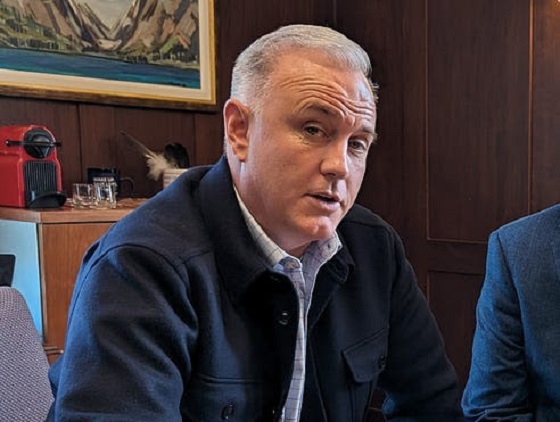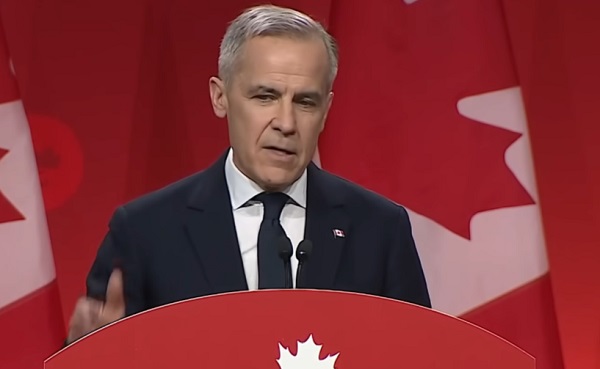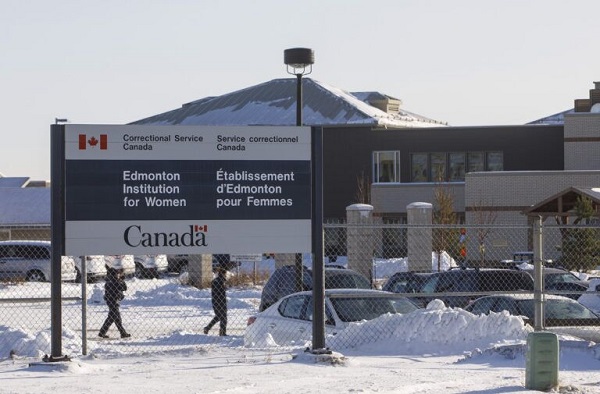Addictions
Alberta and opioids II: Marshall Smith’s ambitious campaign

Marshall Smith. Photo: PW
Click here to subscribe to The Paul Wells Newsletter.
Alberta’s system builder
The Alberta model, made in BC
“I, as you know, have been everywhere in this field, from eating out of garbage cans to this office,” Marshall Smith said. “So I have a deep respect for everybody who works along that continuum.”
We were sitting in the office at the Alberta Legislature reserved for chiefs of staff to Alberta premiers. That’s Smith’s current job. Premier Danielle Smith was probably nearby, though I didn’t see her on this trip. On a shelf behind Marshall Smith were two coffee mugs of different design, each bearing the inscription WAKE UP. SAVE LIVES. REPEAT.
Thank you for reading Paul Wells. This post is public so feel free to share it.
Anyway, Marshall Smith (all future uses of “Smith” in this post will refer to him, unless I specify the premier) was talking about the continuum from dumpsters to the centre of power. “Where you work on that continuum obviously colours the way that you enter this conversation,” he said. “When you are standing on a sidewalk with a person in front of you, the solutions to that person’s problem look very different than what you might do to plan a broader system of care, for a large population of people.”
This was his way of anticipating criticisms he faces as a leading strategist behind Alberta’s emerging strategy for handling a deadly progression in opioid doses. Since he entered Alberta’s government as a more junior staffer in the government of former premier Jason Kenney in 2019, Smith has been working to put a much greater emphasis on recovery from addiction than on “harm reduction,” whose valuable goal is to keep drug users alive whether they recover or not. This makes him a bête noire among harm-reduction advocates. (You can read a mild critique of his efforts here; or a real scorcher here).
What Smith was saying was, in effect, If you work on the street, you’re going to be all about harm reduction, and I respect that. But he is working on drug policy for a whole province, and perhaps beyond, so he needs a broader perspective. “I’m a system builder. So I don’t have the luxury of just focusing on one particular substance. I have to worry about the whole population. I have to worry about the disease burden of addiction and drug use more broadly.”
He sees much to worry about. “Over the last 30 years in Canada, successive governments have failed miserably to anticipate and adequately address the type of services — both from a capital investment and an operating investment — to help people do this.” By “this,” he means escaping addiction. “We have not cared about people with mental health and addiction issues. And we had the ability to not care because up until the last six or seven years, the evidence of them was hidden away.”
Smith first started thinking about this when he was in British Columbia, where he began his recovery from a history of drug use. In 2018, at the BC Centre for Substance Use, Smith co-wrote a report with Dr. Evan Wood that called for a large new investment in facilities and programs to help people recover from addiction. The report is no longer on the BCCSU website, but you can download a copy here.
“It was a 39-point strategy to transform the system in British Columbia,” Smith recalled. “The government of British Columbia wasn’t interested in that strategy. They wanted to go a particular direction.
“So that report is now known as the Alberta model.”
I’m leaving the paywall off these stories because I want them to be widely shared and discussed. But the reason I’m able to report and present big stories like this, with the travel and expenses that involves, is because many of my readers choose to become paying subscribers. If you want to support my work and get full access to everything I write, here’s the button.

Marshall Smith in the dining hall of the Lakeview Recovery Community, opening in July. Photo: PW
In its first page, the Wood/Smith report said “British Columbia has long suffered because of the lack of an effective system to support individuals in and pursuing recovery from substance use disorders.” The system’s “overwhelming focus” was on keeping people alive rather than helping them get better. Wood and Smith wanted that to change.
The need for major new investments in addiction recovery was essentially uncontroversial in B.C. Indeed governments there still periodically announce they are making such investments. But Smith was perpetually unsatisfied with the scale of that commitment.
A year after BC’s new NDP government could-shouldered his report, Smith began working in the UCP government of Alberta’s then-new premier, Jason Kenney.
“Obviously we started off very modestly,” Smith said. “I worked in an office down in the basement. Mental health and addiction wasn’t a big deal. It really was very much a group of cubicles.”
Today, Alberta’s department of mental health and addiction is the seventh-largest ministry in the provincial government.
“The ROSC transformation that is going on in Alberta is massive. It is one of the most massive whole-of-government system transformations that I’ve seen,” Smith said. The premier chairs a ROSC committee of cabinet with seven ministers.
I guess I’d better unpack that acronym. ROSC stands for “recovery-oriented system of care,” a term that appeared in the 2018 report Smith co-wrote.
So you get the premier and her ministers of mental health and addiction, Indigenous relations, advanced education, health, community and social services, public safety and the attorney general meeting regularly to coordinate recovery policy. The premier’s chief of staff is on the file constantly. As I mentioned on Monday, he devoted a full day to explaining this broad effort to me.
“We spend enormous amounts of time and energy,” Smith said. “All of us live and breathe this. Anybody out there that thinks that we’re just, from a conservative perspective, just cavalierly doing this, that just couldn’t be more untrue. We we are in this completely and totally. We monitor almost everything that goes on in the system.”
What are they working on? Smith said the “recovery” part of that “recovery-oriented system of care” jargon-ball gets most of the attention, because it draws attention to the contrast between harm-reduction and abstinence-based recovery models. But Smith is a wonk, and if anything he is more interested in the “system of care” part. His goal is to ensure that every interaction an opioid user has with the modern government apparatus is designed to encourage recovery from dependency. Since people who use drugs tend to bump up against the state a lot, Alberta’s emerging system has a lot of moving parts. The goal is to hook the parts up more effectively.
One of the other men in Smith’s office, Dr. Nathaniel Day, chimed in. He’s been the lead strategist on substance use at Alberta Health Services. He’s an important Smith collaborator.
“Across Canada,” he said, “the system of care for people with addiction has been fragmented, poorly thought out — convenient.” He meant services had generally only been provided when, and where, it was easy for government to provide them. “If you look at opioid dependency treatment, if you lived in a suburban or rural community, it didn’t matter that you had an opioid use disorder. Tough. We had no services for you.”
Day designed the Virtual Opioid Dependency Program, which provides online consultations to patients anywhere in Alberta, and if needed, prescriptions to medications that can be filled at local pharmacies. For patients without coverage, the medication is free and if their local pharmacist has it in stock, available on the day of the call.
“We went in and said, enough is enough,” Day said. “What would be good enough for you and your family? And how do we take that to everybody?”
Which medication? “In this province, we’re huge fans of gold-standard opioid-replacement medications, and we use it a lot,” Smith said. “We have Sublocade, which is something that other provinces don’t have because it’s very expensive. It’s the injectable version of Suboxone. It’s a subcutaneous injection, it goes under the skin, it lasts for 30 days, where the oral is 24-hour. So that’s a thousand bucks a shot, and we pay for that.”
An obvious point about this is that these so-called opioid agonist treatments, or OATs, are big-time harm reduction. They greatly reduce both withdrawal symptoms and highs. One question that I still have, after watching everything Smith and the Alberta government are doing on drug recovery, is whether other provinces could afford to match it.
Running into those institutions
VODP is useful for people who are able to reach out for help from home. But other potential beneficiaries are distracted, or in distress. Very often they run into the police.
“So we took that technology” — the virtual access to physicians and treatment — “and we gave it to the 34 police agencies that we have in the province,” Smith said.
“We said to the officers, ‘If you encounter somebody who has an opioid-use disorder, you can get them started on opioid-use medication. You can, officer. Here’s the phone number to call. Put them on. We make the arrangements. They go to the pharmacy, right then and there. If they’re on the street, that can be done right in the back of a police car.
“If they are in custody at the cell block and they go into the cell block, we have put paramedics in every cell block in Alberta. So the first thing that happens to somebody when they’re arrested and they go into into municipal cells, they’re met by a paramedic that says, ‘Let’s talk about your substance use. Are you an opioid user? We can offer you immediate treatment right now. Right here. Would you like to do that?’ Through our police programs, we’re probably up to like 4,000 people who have taken us up on that.”
That’s what you can get done in a police cruiser or a holding pen. Lots of people go much further into the correctional system than that. So does Smith’s system of care.
“[Alberta’s] focus on corrections and police right now, admittedly, is the opposite of what some other jurisdictions are focusing on,” Smith said. If anything this was an understatement. A major argument for decriminalization and safe supply is that the last thing a drug user needs is the stigma of a criminal record. Other jurisdictions, Smith said, “are running away from those institutions when they should be running into those institutions.
“I’ll give you a very direct example why.
“We know, from the 2017 coroner’s report in Alberta that 40 percent of the people who died [of opioid-related causes] were in custody in the year prior to their death. That’s a really important piece of information, because it tells me I have a big chunk of population there that — if I can get at them, and if we can change the way that they experience this process — we can make a big dent in these numbers.”
A lot of people in the correctional system have substance-use disorder, even if that’s not what they’re in for. “We said, ‘Let’s really do a different way of thinking on this,’” Smith said. “Even though Corrections is a public-safety agency, we want the Ministry of Mental Health and Addiction to take over all Corrections health care.”
Perhaps four in five detainees, he said, “have alcoholism, addiction and mental-health issues. They’re all pooled up in one place and they’re not doing anything. They’ve got nothing but time on their hands. And I don’t have to build a new building? You’re kidding me! This is fantastic! Why wouldn’t I just put therapists in? So we now have treatment programs inside correctional centers.”
Of course a lot of places do programs for inmates. “But what they’re going to show you when you unpack that is, ‘Well, we give them this workbook,’” Smith said. “What they’re not doing is the deep transformative, therapy work that is necessary. And honestly, Paul, our Therapeutic Living Units are probably the best treatment programs we have in Alberta.”
With that, we piled into Smith’s SUV — Smith, Day and the third member of Smith’s team that day, a physician and consultant named Dr. Paul Sobey. A half-hour later we arrived at the Fort Saskatchewan Correctional Centre, northeast of Edmonton.
Here we visited the Therapeutic Living Unit, a full-time addiction-recovery program for 21 women who are housed separately from the general inmate population. That’s about 10% of the total population of women at Fort Saskatchewan. The program opened in February. Participants, who must apply, run through a 12-hour daily program of activity: morning check-in meetings, physical exercise, twice-daily smudge ceremonies reflecting the large Indigenous population in the correctional system, frequent meetings of Alcoholics Anonymous and Narcotics Anonymous as well as the more recently developed SMART Recovery system. Participants are rarely alone during daylight hours. The program is designed to last for months, which struck me as an unusually long time for a recovery program.
Four of the program’s participants sat on a sofa and talked about their experience in the program. “I’ve been wondering and wondering if a program like this was going to happen,” one said.
“It’s like an answered prayer, honestly,” said another. “So I would just encourage you to keep opening places like this.”
That’s the plan. “We’ve got 12 correctional centers in Alberta,” Smith told me before our road trip. “Our goal is to have Therapeutic Living Units [in all of them]. There will come a time where we have whole correctional centers that are working on this model, right? This requires massive intervention, not tinkering around the edges. This is generational change in the way that we do corrections in Alberta.”
Connections
All of the four young women we heard from said they’re nervous about what happens when they get out of detention. Old acquaintances can encourage a return to old habits. Which is part of the reason why Alberta is also building a network of live-in Recovery Communities, long-term residential rehab programs to reinforce the lessons learned in the TLUs — or to help other people begin recovery if they didn’t arrive via the correctional system.
Once the system is fully built in 2027, “every correctional centre will have a sister Recovery Community,” Smith said. “That’s why we’re building 11 of them around the province. Five of them are on First Nations, in partnership with the First Nations.”
Here’s where the system starts to look like a system. After all, in the broadest outlines nothing’s new here. People in prisons have long received addiction counselling, and the Alberta government and various private groups have long run rehabs. But for the longest time, these assorted parts of the system could barely talk to one another. So the chances of a seamless transition from the correctional system to recovery care were lousy. They’re still not great, because the system is still being built, but the goal is a seamless network of care.
“Services in 2018, 2019 were very disconnected,” Warren Driechel, the Edmonton Police Service deputy chief we met the other day, told me. The bureaucratic runaround that we all have to face can be brutal on people with high needs and impaired function. Say you want to get on AISH, an income-support program for people with a medical condition. To do that, you need a doctor’s appointment. To get one, you need identification. To get ID, you need an address.
Public officials are working to provide services that match that complexity.
In January 2021, the EPS launched a “HELP Unit” to refer people to social services instead of just arresting them.
In September 2023, the police replaced the old holding cells where intoxicated people could dry out and then get dumped back on the street with an Integrated Care Centre where they could connect with social services that operate right in the centre.
And in January 2024, after many of the tent encampments were dismantled, a new Navigation and Support Centre became the city’s hub for providing medical, legal and bureaucratic help for people who have often been bereft.
The Nav Centre has nine shelter beds in the back where people can rest, if needed, while on-site staff and volunteers process their files. (Pets are welcome, unlike in some of the city’s shelters.) The centre has the province’s only on-site Service Alberta photo-ID station. On the day I visited, the Nav Centre assisted 50 people, with 24 visiting the desk run by the Hope Mission, 10 being helped by staff from Radius Health, 12 by the provincial department of mental health and addiction.
Everything old is new
Our final stop was the Lakeview Recovery Community outside Gunn, northwest of Edmonton. When it opens in July, it’ll be the third or fourth in a network of such long-term residential programs. Lethbridge and Red Deer have been open for a while. The goal is to have 11 centres up and running across the province by 2027. Smith hopes that once the full network of centres is open, long wait times in Red Deer and Lethbridge will shrink, perhaps to the point where some beds will be available on-demand.
Each recovery community has its quirks. Lakeview will be for men only. Five of the centres will be on Indigenous land. The minimum stay will be four months, with some residents staying for up to a year. That’s a long stint for a rehab; in some private rehabs, it’s unusual to stay for even a month. In theory every day you spend with a combination of counselling, group therapy, twelve-step programs and medical care will increase your chances of success. No resident will pay for their stay at any recovery community. It’s covered by the government.
Work crews have been renovating the Lakeview site since 2022. It’s an impressive place, roomy and bright, with rooms where residents can meet visiting family, a huge kitchen where residents will learn cooking skills, and a dispensary for opioid agonist treatment. Residents will share bungalows while they’re in the program, five or six to a house.
But it didn’t just come into existence. What’s now Lakeview began its existence as the McCullough Centre for homeless World War II veterans. It had been operating for years as an addiction rehab centre when Jason Kenney’s government closed it in 2021. When the government announced the site’s eventual reopening barely a year later, observers were baffled. Closing the centre fit a narrative about a government that put the bottom line over Albertans’ wellbeing. Refurbishing and reopening it was.. harder to explain. Fitting it into a network of nearly a dozen such centres that will, themselves, be better connected to street-level services and to the corrections system… well, we’ll see, won’t we?
I’m conscious of ending this installment in my series on opioids in Alberta on an ambivalent note. I simply don’t know how this will turn out. My first article, earlier this week, was about the scale of the challenge. This one is about the scale of the response. It’s impressive. It’s getting attention across the country. Sobey, the physician who was the third member of our little party as we toured the region’s facilities, has a consulting firm whose aim is to design recovery-oriented systems of care to any government that wants to start the conversation. His phone pinged with an inquiry from another provincial government while we were visiting the Fort Saskatchewan prison. These ideas may come soon to a province near you.
What we don’t know yet is whether they’ll work, or how well. In the third and final installment in this series, I’ll discuss a few reasons to reserve judgment.
But what Alberta is trying is, in many ways, not heretical. Nobody thinks it’s great design to leave desperate people to wander helplessly thorugh a piecemeal hodge-podge of social services and treatment options, with police and corrections hovering over it all as an aloof menace. Smith, his boss the premier, and several government departments are trying to build a better system.
There is room for many devils in the details. But if federalism is supposed to be a laboratory for testing different approaches to thorny problems, Alberta is testing this approach ambitiously. Watching Marshall Smith, I found myself wondering what other intractable governance problems could benefit from the sustained attention of an empowered senior staffer, a supportive head of government, and ministers and public servants working in close coordination.
2025 Federal Election
Poilievre to invest in recovery, cut off federal funding for opioids and defund drug dens

From Conservative Party Communications
Poilievre will Make Recovery a Reality for 50,000 Canadians
Conservative Leader Pierre Poilievre pledged he will bring the hope that our vulnerable Canadians need by expanding drug recovery programs, creating 50,000 new opportunities for Canadians seeking freedom from addiction. At the same time, he will stop federal funding for opioids, defund federal drug dens, and ensure that any remaining sites do not operate within 500 meters of schools, daycares, playgrounds, parks and seniors’ homes, and comply with strict new oversight rules that focus on pathways to treatment.
More than 50,000 people have lost their lives to fentanyl since 2015—more Canadians than died in the Second World War. Poilievre pledged to open a path to recovery while cracking down on the radical Liberal experiment with free access to illegal drugs that has made the crisis worse and brought disorder to local communities.
Specifically, Poilievre will:
- Fund treatment for 50,000 Canadians. A new Conservative government will fund treatment for 50,000 Canadians in treatment centres with a proven record of success at getting people off drugs. This includes successful models like the Bruce Oake Recovery Centre, which helps people recover and reunite with their families, communities, and culture. To ensure the best outcomes, funding will follow results. Where spaces in good treatment programs exist, we will use them, and where they need to expand, these funds will allow that.
- Ban drug dens from being located within 500 metres of schools, daycares, playgrounds, parks, and seniors’ homes and impose strict new oversight rules. Poilievre also pledged to crack down on the Liberals’ reckless experiments with free access to illegal drugs that allow provinces to operate drug sites with no oversight, while pausing any new federal exemptions until evidence justifies they support recovery. Existing federal sites will be required to operate away from residential communities and places where families and children frequent and will now also have to focus on connecting users with treatment, meet stricter regulatory standards or be shut down. He will also end the exemption for fly-by-night provincially-regulated sites.
“After the Lost Liberal Decade, Canada’s addiction crisis has spiralled out of control,” said Poilievre. “Families have been torn apart while children have to witness open drug use and walk through dangerous encampments to get to school. Canadians deserve better than the endless Liberal cycle of crime, despair, and death.”
Since the Liberals were first elected in 2015, our once-safe communities have become sordid and disordered, while more and more Canadians have been lost to the dangerous drugs the Liberals have flooded into our streets. In British Columbia, where the Liberals decriminalized dangerous drugs like fentanyl and meth, drug overdose deaths increased by 200 percent.
The Liberals also pursued a radical experiment of taxpayer-funded hard drugs, which are often diverted and resold to children and other vulnerable Canadians. The Vancouver Police Department has said that roughly half of all hydromorphone seizures were diverted from this hard drugs program, while the Waterloo Regional Police Service and Niagara Regional Police Service said that hydromorphone seizures had exploded by 1,090% and 1,577%, respectively.
Despite the death and despair that is now common on our streets, bizarrely Mark Carney told a room of Liberal supporters that 50,000 fentanyl deaths in Canada is not “a crisis.” He also hand-picked a Liberal candidate who said the Liberals “would be smart to lean into drug decriminalization” and another who said “legalizing all drugs would be good for Canada.”
Carney’s star candidate Gregor Robertson, an early advocate of decriminalization and so-called safe supply, wanted drug dens imposed on communities without any consultation or public safety considerations. During his disastrous tenure as Vancouver Mayor, overdoses increased by 600%.
Alberta has pioneered an approach that offers real hope by adopting a recovery-focused model of care, leading to a nearly 40 percent reduction in drug-poisoning deaths since 2023—three times the decrease seen in British Columbia. However, we must also end the Liberal drug policies that have worsened the crisis and harmed countless lives and families.
To fund this policy, a Conservative government will stop federal funding for opioids, defund federal drug dens, and sue the opioid manufacturers and consulting companies who created this crisis in the first place.
“Canadians deserve better than the Liberal cycle of crime, despair, and death,” said Poilievre. “We will treat addiction with compassion and accountability—not with more taxpayer-funded poison. We will turn hurt into hope by shutting down drug dens, restoring order in our communities, funding real recovery, and bringing our loved ones home drug-free.”
Addictions
There’s No Such Thing as a “Safer Supply” of Drugs

By Adam Zivo
Sweden, the U.K., and Canada all experimented with providing opioids to addicts. The results were disastrous.
[This article was originally published in City Journal, a public policy magazine and website published by the Manhattan Institute for Policy Research. We encourage our readers to subscribe to them for high-quality analysis on urban issues]
Last August, Denver’s city council passed a proclamation endorsing radical “harm reduction” strategies to address the drug crisis. Among these was “safer supply,” the idea that the government should give drug users their drug of choice, for free. Safer supply is a popular idea among drug-reform activists. But other countries have already tested this experiment and seen disastrous results, including more addiction, crime, and overdose deaths. It would be foolish to follow their example.
The safer-supply movement maintains that drug-related overdoses, infections, and deaths are driven by the unpredictability of the black market, where drugs are inconsistently dosed and often adulterated with other toxic substances. With ultra-potent opioids like fentanyl, even minor dosing errors can prove fatal. Drug contaminants, which dealers use to provide a stronger high at a lower cost, can be just as deadly and potentially disfiguring.
Because of this, harm-reduction activists sometimes argue that governments should provide a free supply of unadulterated, “safe” drugs to get users to abandon the dangerous street supply. Or they say that such drugs should be sold in a controlled manner, like alcohol or cannabis—an endorsement of partial or total drug legalization.
But “safe” is a relative term: the drugs championed by these activists include pharmaceutical-grade fentanyl, hydromorphone (an opioid as potent as heroin), and prescription meth. Though less risky than their illicit alternatives, these drugs are still profoundly dangerous.
The theory behind safer supply is not entirely unreasonable, but in every country that has tried it, implementation has led to increased suffering and addiction. In Europe, only Sweden and the U.K. have tested safer supply, both in the 1960s. The Swedish model gave more than 100 addicts nearly unlimited access through their doctors to prescriptions for morphine and amphetamines, with no expectations of supervised consumption. Recipients mostly sold their free drugs on the black market, often through a network of “satellite patients” (addicts who purchased prescribed drugs). This led to an explosion of addiction and public disorder.
Most doctors quickly abandoned the experiment, and it was shut down after just two years and several high-profile overdose deaths, including that of a 17-year-old girl. Media coverage portrayed safer supply as a generational medical scandal and noted that the British, after experiencing similar problems, also abandoned their experiment.
While the U.S. has never formally adopted a safer-supply policy, it experienced something functionally similar during the OxyContin crisis of the 2000s. At the time, access to the powerful opioid was virtually unrestricted in many parts of North America. Addicts turned to pharmacies for an easy fix and often sold or traded their extra pills for a quick buck. Unscrupulous “pill mills” handed out prescriptions like candy, flooding communities with OxyContin and similar narcotics. The result was a devastating opioid epidemic—one that rages to this day, at a cumulative cost of hundreds of thousands of American lives. Canada was similarly affected.
The OxyContin crisis explains why many experienced addiction experts were aghast when Canada greatly expanded access to safer supply in 2020, following a four-year pilot project. They worried that the mistakes of the recent past were being made all over again, and that the recently vanquished pill mills had returned under the cloak of “harm reduction.”
Subscribe for free to get BTN’s latest news and analysis – or donate to our investigative journalism fund.
Most Canadian safer-supply prescribers dispense large quantities of hydromorphone with little to no supervised consumption. Patients can receive up to 40 eight-milligram pills per day—despite the fact that just two or three are enough to cause an overdose in someone without opioid tolerance. Some prescribers also provide supplementary fentanyl, oxycodone, or stimulants.
Unfortunately, many safer-supply patients sell or trade a significant portion of these drugs—primarily hydromorphone—in order to purchase more potent illicit substances, such as street fentanyl.
The problems with safer supply entered Canada’s consciousness in mid-2023, through an investigative report I wrote for the National Post. I interviewed 14 addiction physicians from across the country, who testified that safer-supply diversion is ubiquitous; that the street price of hydromorphone collapsed by up to 95 percent in communities where safer supply is available; that youth are consuming and becoming addicted to diverted safer-supply drugs; and that organized crime traffics these drugs.
Facing pushback, I interviewed former drug users, who estimated that roughly 80 percent of the safer-supply drugs flowing through their social circles was getting diverted. I documented dozens of examples of safer-supply trafficking online, representing tens of thousands of pills. I spoke with youth who had developed addictions from diverted safer supply and adults who had purchased thousands of such pills.
After months of public queries, the police department of London, Ontario—where safer supply was first piloted—revealed last summer that annual hydromorphone seizures rose over 3,000 percent between 2019 and 2023. The department later held a press conference warning that gangs clearly traffic safer supply. The police departments of two nearby midsize cities also saw their post-2019 hydromorphone seizures increase more than 1,000 percent.
The Canadian government quietly dropped its support for safer supply last year, cutting funding for many of its pilot programs. The province of British Columbia (the nexus of the harm-reduction movement) finally pulled back support last month, after a leaked presentation confirmed that safer-supply drugs are getting sold internationally and that the government is investigating 60 pharmacies for paying kickbacks to safer-supply patients. For now, all safer-supply drugs dispensed within the province must be consumed under supervision.
Harm-reduction activists have insisted that no hard evidence exists of widespread diversion of safer-supply drugs, but this is only because they refuse to study the issue. Most “studies” supporting safer supply are produced by ideologically driven activist-scholars, who tend to interview a small number of program enrollees. These activists also reject attempts to track diversion as “stigmatizing.”
The experiences of Sweden, the United Kingdom, and Canada offer a clear warning: safer supply is a reliably harmful policy. The outcomes speak for themselves—rising addiction, diversion, and little evidence of long-term benefit.
As the debate unfolds in the United States, policymakers would do well to learn from these failures. Americans should not be made to endure the consequences of a policy already discredited abroad simply because progressive leaders choose to ignore the record. The question now is whether we will repeat others’ mistakes—or chart a more responsible course.
Our content is always free –
but if you want to help us commission more high-quality journalism,
consider getting a voluntary paid subscription.
-

 John Stossel2 days ago
John Stossel2 days agoGovernment Gambling Hypocrisy: Bad Odds and No Competition
-

 2025 Federal Election2 days ago
2025 Federal Election2 days agoCommunist China helped boost Mark Carney’s image on social media, election watchdog reports
-

 2025 Federal Election23 hours ago
2025 Federal Election23 hours agoRCMP memo warns of Chinese interference on Canadian university campuses to affect election
-

 2025 Federal Election2 days ago
2025 Federal Election2 days agoFifty Shades of Mark Carney
-

 Alberta2 days ago
Alberta2 days agoAlberta’s embrace of activity-based funding is great news for patients
-

 2025 Federal Election2 days ago
2025 Federal Election2 days agoConservative Party urges investigation into Carney plan to spend $1 billion on heat pumps
-

 MAiD1 day ago
MAiD1 day agoDisability rights panel calls out Canada, US states pushing euthanasia on sick patients
-

 Justice1 day ago
Justice1 day agoCanadian government sued for forcing women to share spaces with ‘transgender’ male prisoners













